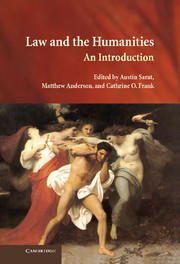Book contents
- Frontmatter
- Contents
- Contributors
- Acknowledgments
- Introduction: On the Origins and Prospects of the Humanistic Study of Law
- I PERSPECTIVES ON THE HISTORY AND SIGNIFICANCE OF SCHOLARSHIP IN LAW AND THE HUMANITIES: THREE VIEWS
- II IDEAS OF JUSTICE
- III IMAGINING THE LAW
- 8 Imagining the Law: The Novel
- 9 Imagining Law as Film (Representation without Reference?)
- 10 Law and Television: Screen Phenomena and Captive Audiences
- 11 Imagining the Law: Art
- IV LINGUISTIC, LITERARY, AND CULTURAL PROCESSES IN LAW
- V INSTITUTIONAL PROCESSES
- Index
- References
10 - Law and Television: Screen Phenomena and Captive Audiences
Published online by Cambridge University Press: 20 January 2010
- Frontmatter
- Contents
- Contributors
- Acknowledgments
- Introduction: On the Origins and Prospects of the Humanistic Study of Law
- I PERSPECTIVES ON THE HISTORY AND SIGNIFICANCE OF SCHOLARSHIP IN LAW AND THE HUMANITIES: THREE VIEWS
- II IDEAS OF JUSTICE
- III IMAGINING THE LAW
- 8 Imagining the Law: The Novel
- 9 Imagining Law as Film (Representation without Reference?)
- 10 Law and Television: Screen Phenomena and Captive Audiences
- 11 Imagining the Law: Art
- IV LINGUISTIC, LITERARY, AND CULTURAL PROCESSES IN LAW
- V INSTITUTIONAL PROCESSES
- Index
- References
Summary
Various journalists and scholars have described the now well-known “CSI effect.” Max Houck, director of forensic business development at West Virginia University, has said, “The CSI effect is basically the perception of the near-infallibility of forensic science in response to the TV show.” I would like to use this perception as a point of entry into the complex relationship between law and television. What is interesting about the CSI effect is not so much that television shows like CSI have altered public perception of the way the law does (or should) work, but that the step from the role of television spectator into the role of juror should seem so natural in the first place. Television has been altering audience expectations since its inception, but there is no “House effect,” no “ER effect,” no “Boston Public effect.” Why is it in the domain of the law that viewers feel implicated in – and drawn to comment on – the preservation of law's correct operation? The answer to this question comes in part from the fact of the jury system, which gives real individuals an actual active voice in determining legal outcomes. Most crimes, though, do not go to trial, and most jurors who serve do not end up on murder trials. The presence of the CSI effect has also to do with the ways in which law on television interpolates the viewer: at once as a singular witness, and also as a potential stand-in for a crucial enforcer.
- Type
- Chapter
- Information
- Law and the HumanitiesAn Introduction, pp. 269 - 291Publisher: Cambridge University PressPrint publication year: 2009



